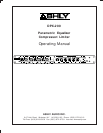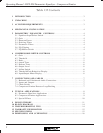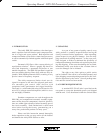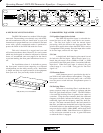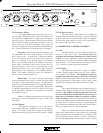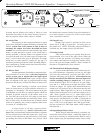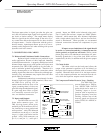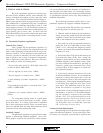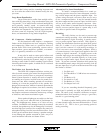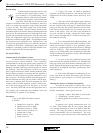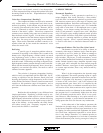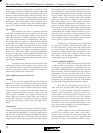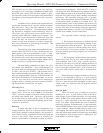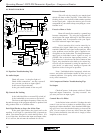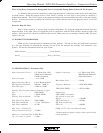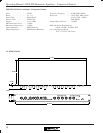
8
Operating Manual - DPX-200 Parametric Equalizer - Compressor/Limiter
8. TYPICAL APPLICATIONS
By itself, a parametric equalizer is useful for gen-
eral tone control, feedback control, room resonance cor-
rection, individual microphone voicing, and many other
applications. The compressor/limiter provides many so-
lutions where dynamic signal level processing is required.
The combination of a parametric EQ and a compressor/
limiter allows for additional applications, such as a full
range speaker processor, 70 volt distributed system pro-
cessor, mixing console channel insert, and frequency sen-
sitive limiting, just to name a few. In most cases, the
DPX-200 should be the last device before the power amp
or crossover, or right before a recording device or trans-
mitter.
8.1 Parametric Equalizer Applications
General Tone Control
Like a graphic EQ, the parametric equalizer is a
very useful device for general tone shaping because the
filter’s center frequency, bandwidth and level are all con-
tinuously variable. To use the power of the equalizer ef-
fectively, you need to translate your idea of the tone you
want to produce into a range of numerical frequencies.
This is simple after a little practice. Here are a few refer-
ences which are useful for starting points:
- Very low bass (the “wind” in a kick drum, almost felt
as much as heard -40Hz-80Hz.
- The low register of a male voice - 200Hz
- The low register of a female voice - 350Hz
- Lower midrange (“warmth” frequencies) - 400Hz-
1KHz
- Upper midrange (“harshness”, snare drum “bite”, “hot”
sound) -2.5KHz-4KHz.
- Sibilance (“sss” sounds, cymbal “sizzle”) - 8KHz-
15KHz.
Try using these starting points as a guide when
you want more or less of these types of sounds. Adjust
by ear from there. It is always a good idea to remember
that a little equalization usually works out much better
than a lot, and that there are many audio problems which
cannot be solved with equalization alone.
Feedback Control
The parametric equalizer is a powerful tools when
applied to eliminating feedback problems. On a tradi-
tional graphic equalizer, the fixed filter center frequen-
cies are insufficient when the frequency of feedback oc-
curs between two slide faders, or is extremely narrow.
The continuously variable center frequency and bandwidth
of a parametric equalizer allows very sharp notching of
feedback frequencies.
The following procedure outlines how to use a
parametric equalizer to suppress feedback frequencies:
1. Start with all the EQ switches out except the
master EQ switch in and the gain at 0.
2. With the entire PA hooked up and turned on,
slowly increase the sound level at the mixer until
feedback is heard, then lower the level by about
3 dB so that feedback does not continue.
3. Start with one of the two parametric filters by
setting the level at 0, bandwidth set fairly sharp
(about .3 oct.), and adjust the frequency control
to where you estimate the predominate feedback
frequency to occur.
4. Push in the filter’s EQ switch and increase its
level control by about +6 dB. Now “sweep” the
frequency around where you have estimated the
feedback frequency until feedback occurs. Once
you have induced the feedback by boosting its
frequency, quickly turn down the filter’s level
control to about -6 dB to suppress or “notch out”
the feedback frequency.
5. Again slowly increase the master level at the
mixer until feedback is heard. If a new feedback
frequency is heard, then repeat step 3 with the
other parametric filter to find and suppress the
new frequency. If the original feedback frequency
is still heard, then adjust the first filter’s level
even lower. The bandwidth control may be ad-
justed full clockwise to produce a very sharp
notch so that a severe feedback frequency can be
attenuated by as much as 15 dB without degrad-
ing the frequency response with noticeable
notches. Note: Very sharp bandwidth lowers the
maximum equalizer input level because of the
high filter gain necessary to obtain such a nar-
row bandwidth. Only use bandwidth control full
CW (.05 Octave) in severe cases.
Console Channel Equalization
Many mixing consoles provide only simple equal-
ization for individual channels. If your console has chan-
nel inserts, you can patch your parametric equalizer into



